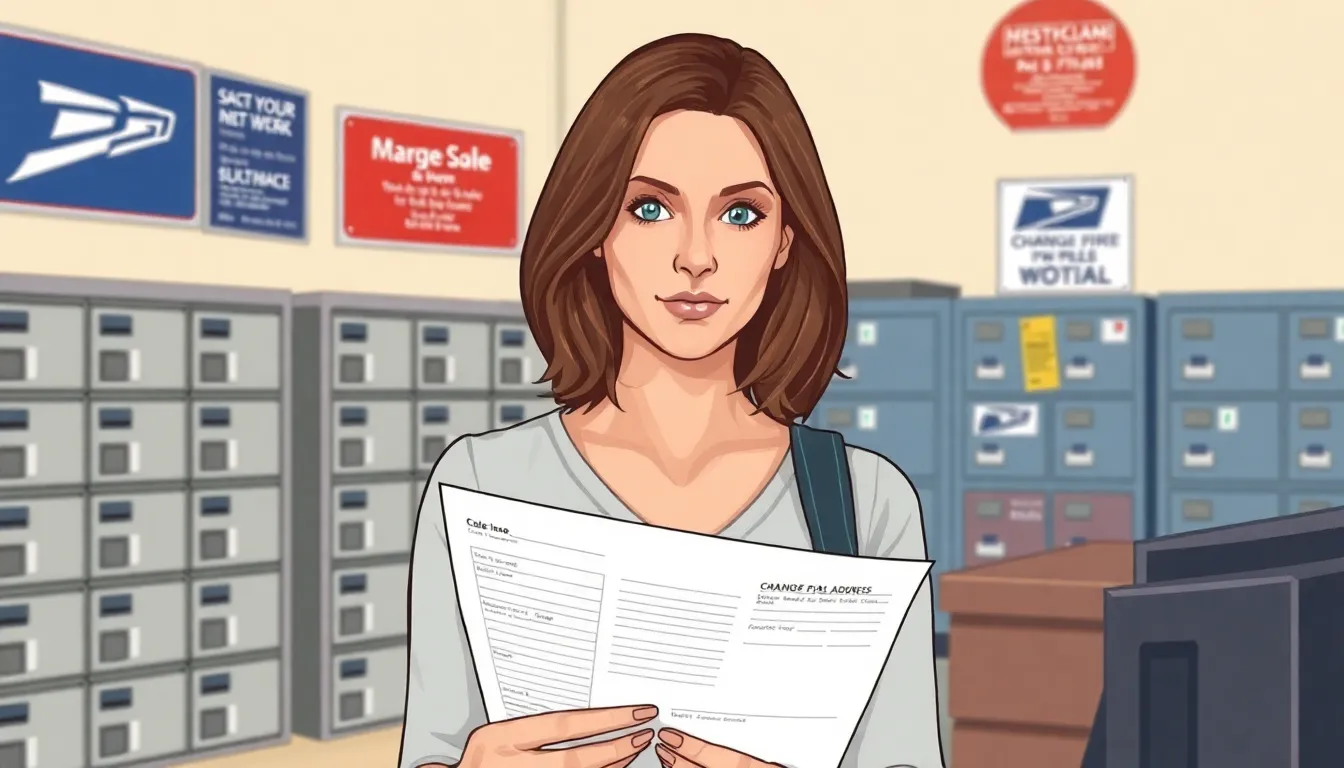Moving can feel like a circus act, juggling boxes, packing tape, and a few too many cups of coffee. With all the chaos, it’s easy to forget the essential steps that can turn this daunting task into a well-orchestrated event. Whether it’s your first move or you’re a seasoned pro, having a game plan can save the day and your sanity.
Table of Contents
ToggleCreate a Moving Checklist
Creating a moving checklist streamlines the process and minimizes chaos. A detailed plan reduces stress and improves organization.
Organize Your Tasks
Start by breaking down the overall moving process into manageable tasks. Categorize items such as packing, notifying utilities, and addressing change of address. Group similar activities together to enhance efficiency. Prioritize tasks with deadlines in mind, ensuring that high-importance items are completed first. Review progress regularly, adjusting the checklist as necessary to accommodate unexpected changes. Actively involving family members or friends can make the process quicker and more efficient.
Set a Timeline
Develop a realistic timeline to keep moving tasks on track. Create a countdown leading up to moving day, specifying target dates for each task. For instance, allocate four weeks for packing supplies and three weeks for arranging utility transfers. Ensure the timeline accounts for any specific requirements, like scheduling professional movers. Continuous monitoring of progress and adjusting the timeline can prevent last-minute rushes. Prioritize early tasks that lay the groundwork for later steps.
Notify Important Parties

Notifying important parties ensures a smooth transition during a move. Addressing these notifications promptly helps prevent disruptions in services or communications.
Change of Address
Change of address forms inform the postal service about the move. Prioritize submitting these forms online or at the local post office at least two weeks before moving day. This action guarantees that mail gets forwarded to the new residence without delays. Update personal information with banks, insurance companies, and subscription services as well. Confirm all records reflect the new address to avoid confusion and maintain financial security.
Utility Providers
Contact utility providers early to schedule disconnections and connections at the new location. Request service transfer or installations for electricity, gas, water, and internet about two weeks in advance. Schedule appointments to ensure services expect the move date and minimize downtime. Inform providers about any specific needs or timing concerns during the process. Verify accounts reflect the new address to maintain continuity in services.
Sort and Declutter
Sorting and decluttering streamline the moving process and reduce stress. Effective organization within this task creates a more manageable environment leading to a successful move.
Item Categorization
Begin by assessing all belongings, including furniture, clothing, and appliances. Organizing items into categories helps identify what to keep, donate, or dispose of. Set aside boxes labeled “keep,” “donate,” and “trash” for clarity. Evaluate each item critically, asking whether it adds value or has been used in the past year. Prioritize important items during this phase to ensure only essentials make the move.
Donation and Disposal Options
Explore local charities and organizations for donating items in good condition. Many shelters, thrift stores, and community centers accept furniture, clothes, and household goods. Research pick-up services, as some organizations offer convenient arrangements. Disposal of non-donatable items must follow local regulations; check waste collection guidelines for proper disposal methods. Schedule drop-offs or pick-ups early to avoid last-minute hassles.
Pack Efficiently
Packing efficiently streamlines the moving process and minimizes stress. Focus on preparing in advance to ensure a smoother transition.
Packing Supplies
Gather essential packing supplies before the move begins. Boxes in various sizes accommodate items of all shapes. Use bubble wrap and packing paper to protect fragile belongings. Markers for labeling boxes clearly define contents and designated rooms. Don’t forget tape and scissors, which streamline sealing boxes. Consider wardrobe boxes that can hold hanging clothes and eliminate extra folding. Packing supplies contribute significantly to an organized and efficient packing experience.
Room by Room Approach
Adopt a room-by-room approach to simplify packing. Start with less frequently used spaces, allowing more time to sort through items. Carefully pack one room at a time to prevent chaos. Label each box room explicitly and indicate if it contains fragile items. Prioritize packing essentials last, ensuring they remain accessible until moving day. This method prevents mixing items from different rooms, making unpacking smooth and organized. A focused approach leads to an efficient packing process and reduces last-minute stress.
Hire Professionals or Move Yourself
Deciding whether to hire professionals or move oneself impacts the overall moving experience. Both options have distinct advantages that can simplify the process.
Benefits of Hiring Movers
Hiring professional movers provides valuable expertise for a smoother relocation. They carry the experience to handle heavy and fragile items with care, reducing the risk of damage. Professional teams can also manage logistics, minimizing the time needed for packing and loading. Additionally, many moving companies offer insurance, adding a layer of financial protection if anything goes wrong during transit. It’s important to note that these services afford peace of mind, allowing individuals to focus on other aspects of the move.
DIY Moving Tips
Opting for a DIY move can save substantial costs while presenting challenges. Gathering all necessary supplies, such as boxes and packing tape, helps ensure a successful packing process. Planning the route and scheduling the moving day in advance prevents last-minute complications. Involving friends or family can enhance efficiency and make the experience more enjoyable. Labeling all packed boxes clearly promotes easy identification during unpacking. Maintaining a checklist throughout the move allows for better organization and tracking of completed tasks.
Prepare for Moving Day
Preparation enhances the efficiency of moving day. Following essential tips ensures a smoother experience.
Essential Supplies
Gathering necessary supplies is vital. Boxes of various sizes accommodate different types of items. Packing tape secures box flaps to prevent spills. Bubble wrap and packing paper protect fragile items effectively. Markers label each box with its contents and the room it belongs to. Scissors simplify the process of opening boxes during the unpacking phase. Include furniture pads to safeguard larger items from damage. Ensure to have a first aid kit handy for any minor emergencies that may arise. Stock up on trash bags for easy disposal of any leftover packing materials. Having these supplies readily available helps create an organized and efficient moving process.
Last-Minute Tasks
Completing last-minute tasks prevents chaos on moving day. Double-check the checklist for any overlooked items. Confirm utility connections, ensuring services are active at the new location. Ensure that personal items like passports, bills, and valuables are easily accessible. Verify that all boxes are correctly labeled for efficient unloading. Pack a separate essentials bag containing necessary items like clothing, toiletries, and medications. Inform friends or family about the moving schedule for additional support. Take a final walk-through of the old home to check for forgotten belongings. Completing these tasks fosters a hassle-free transition to the new home.
Settle into Your New Home
Settling into a new home requires organization and creativity to ensure comfort and function. Addressing unpacking and personalization can enhance the transition.
Unpacking Strategy
Start unpacking the essentials first. Prioritize the kitchen and bedroom, since these areas support daily activities. Unpack supplies such as dishes and bedding to establish basic functionality. Consider using a specific room for unpacking to minimize clutter in other areas. Group similar items together to make organization easier. As boxes empty, recycle or dispose of them promptly to keep the space tidy. Lastly, unpacking progressively helps reduce overwhelm and create a welcoming environment quickly.
Personalizing Your Space
Personalization adds character to a newly settled space. Begin by choosing color palettes and decor styles that resonate with the individual. Arranging furniture sets an inviting atmosphere and improves flow in the room. Hang artwork and photographs that reflect personal interests or cherished memories, enhancing the emotional connection to the space. Consider using plants to introduce vibrancy and freshness, contributing to a lively ambiance. Curate decorative items that showcase individuality, ensuring the home feels distinctly personal from the outset.
Moving can be a daunting task but with the right strategies in place, it can transform into a manageable and even enjoyable experience. By creating a detailed checklist and timeline, individuals can stay organized and focused throughout the process. Sorting and decluttering not only lightens the load but also sets the stage for a fresh start in the new home.
Whether opting for professional movers or a DIY approach, prioritizing essential tasks ensures a smoother transition. Once settled, personalizing the new space fosters a sense of belonging. Embracing these steps will not only ease the moving process but also help create a welcoming environment that truly feels like home.





